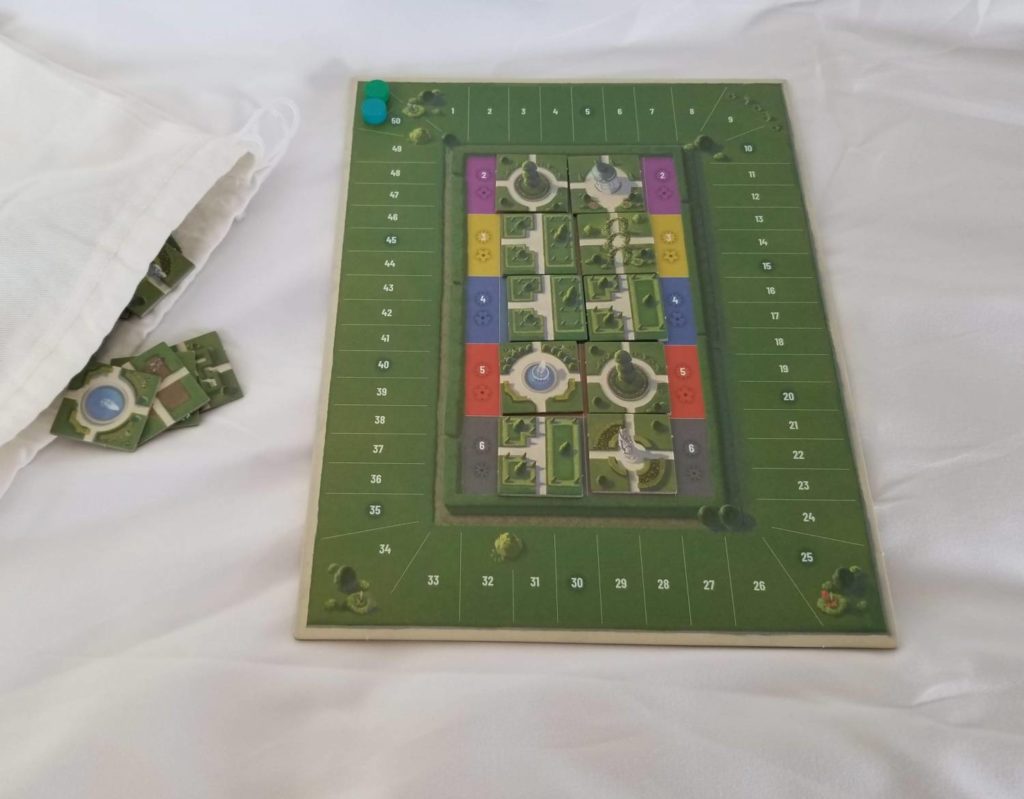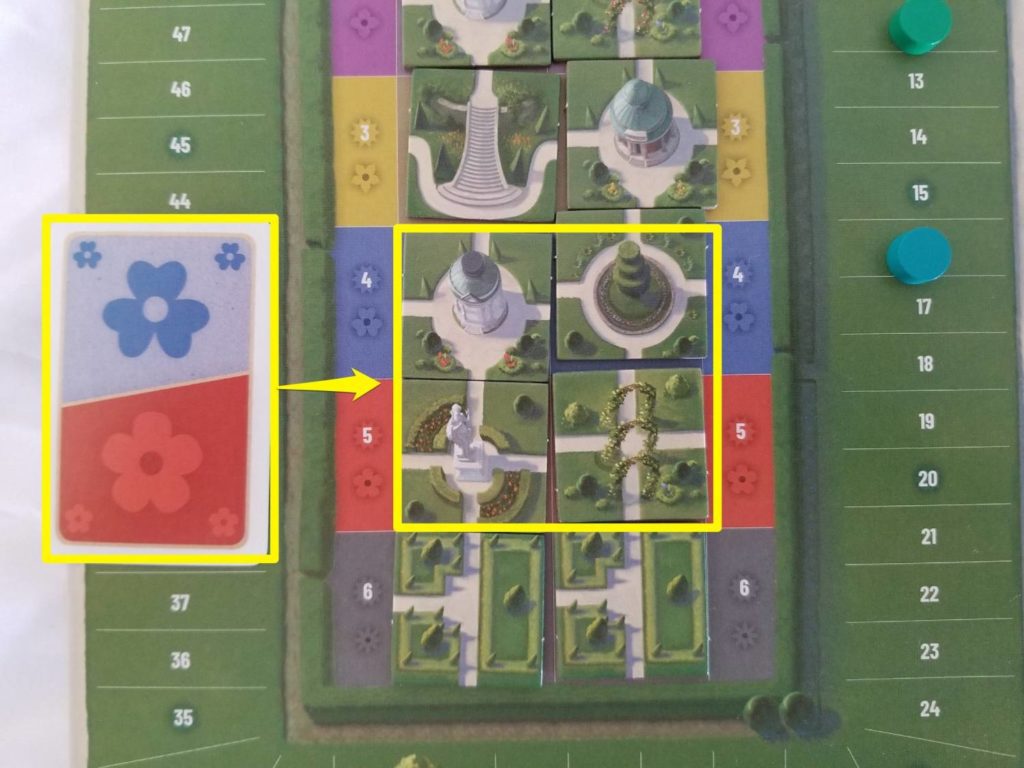From Wikipedia: “Sanssouci is a historical building in Potsdam, near Berlin. Built by Prussian King Frederick the Great as his summer palace, it is often counted among the German rivals of Versailles. While Sanssouci is in the more intimate Rococo style and is far smaller than its French Baroque counterpart, it, too, is notable for the numerous temples and follies in the surrounding park. The palace was designed and built by Georg Wenzeslaus von Knobelsdorff between 1745 and 1747 to meet Frederick’s need for a private residence where he could escape the pomp and ceremony of the royal court.”
First published in 2013, the board game Sanssouci takes its inspiration from the eponymous palace. Welcomed with a lot of fanfare and attention, it didn’t take long for Sanssouci to find itself on the Official Recommendation list for the 2014 Spiel des Jahres. Even though it didn’t win the ultimate prize, it was still very well regarded. So much so, in fact, that it received a reprint earlier this year, which is the subject of this review.
In Sanssouci, the players take on the roles of landscapers tasked with improving the grounds surrounding the titular palace. Each player begins the game with a shuffled deck of cards which is identical to their opponents’ decks. On their turn, a player will add a card from their deck to their hand, and then they will use one of those cards to obtain a tile from the Main board to add to their Palace Gardens board. These boards are divided into six rows and nine columns with a Nobleman at the top of each column. By strategically adding tiles to the Palace Gardens, the players will be able to move these Noblemen down their respective columns to earn points and, once the game ends, the player that has earned the most points wins the game.
Of course, this is a very high level overview of the game. If you’re already familiar with how the game is played and just want to know what I think about it, feel free to skip ahead to the Thoughts section. Otherwise, read on as we discuss how to play Sanssouci and how the 2nd Edition differs from the 1st.
Setup
Sanssouci 2nd Edition (heretofore referred to as simply Sanssouci) is set up thusly:
Set out the Main board. Then, place all of the Garden tiles into the drawstring bag, give it a good shake, and draw and place a tile into each of the ten colored squares in the center of the board.

Next, each player receives a double-sided Palace Gardens board and chooses a side to play with. Then, after choosing a color, they receive the nine Noblemen pawns, the Counting Stone, and the card deck in their chosen color. Each Nobleman is set at the top of one of the nine columns on the player’s Palace Gardens board. Then, their deck of cards is shuffled into a face down deck and set close by. They will then draw two cards from this deck to form their opening hand. Also, shuffle the Mission cards and deal two of these to each player, who will keep them hidden. Each player’s Counting Stone will begin on the 0/50 space of the score track on the Main board.

Finally, determine a start player by some means and you’re ready to begin playing.
Gardening
Your turn in Sanssouci will consist of three main actions: play a card, gain a tile, and place the tile. Well, it’s slightly more complex than this, but only slightly. These are followed by a fourth, optional action: moving a Nobleman, which I’ll cover in its own section.
There are two types of cards in the game, colors and symbols. Each color card contains a pair of colors (there’s one card that contains all five). These colors correspond to the spaces in the middle of the Main board. When you play one of them, you will collect one of the tiles from one of the color locations matching one of the colors on the played card. Then you place that tile onto your Palace Gardens board so that the tile is in the same row as the color, and the image on the tile matches the image on the Palace Gardens board.

For example, if you play a blue/red card, then you can select the tile from one of the two blue spots or a tile from one of the two red spots. So, let’s pretend you select a tile featuring a staircase from one of the red spots. You would place that tile in the staircase column on the red row. If there’s already a staircase tile on that location, then you would flip the tile to its opposite (a.k.a. ‘gardener’) side, and place it into any empty location within the same row or column. This gardener placement is true for any tile that would be placed onto a location that already has a tile on it.
The symbol cards work in pretty much the same way. When you play one of these, you can pick up a tile with a matching symbol from any of the color spots and then place it into the location of the column matching the symbol, in the row matching the color of where the tile was taken from, following the previously mentioned gardener rule if there’s already a tile there. If there is no matching symbol in any of the color spots, then you can pick up any tile you wish and place it into its matching column in the row matching the color spot from which it was taken, unless that column’s full, in which case, the tile flips to its gardener side.

So, imagine there are three Pavilion tiles present on the Main board and you play a Pavilion card from your hand. You can select any one of those Pavilion tiles to play onto your Palace Gardens board. If you pick up the Pavilion tile from the blue color spot, that Pavilion tile would need to be placed into the blue row.
Nobility
After placing your tile, you then have the option of moving one of your Noblemen down its column to earn points. The path that it takes to reach the lower column level doesn’t have to be a straight shot either. If need be, the Nobleman can travel along the path, which will form as tiles are placed, to neighboring tiles, until it reaches a lower tile in the column. And once the Nobleman comes to rest, it will earn points equal to whichever row it ended up on.

Noblemen can never travel backwards. It’s important to keep this in mind as you’re constructing your garden paths. And once you’ve finished (optionally) moving your Nobleman, you replace the tile that you took with one drawn from the bag and draw another card to refill your hand to two cards. Then it becomes the next person’s turn.
End Game
The game comes to an end after the last player has played their last card and placed their last tile. Then final scores are tallied to determine the winner. Completed columns are worth five points. Completed rows are worth ten. Each Mission card depicts a symbol. Additional points are earned based on which row the Nobleman in the column matching that symbol wound up in. These are added to the points the players earned during the course of the game to determine their final scores.
Bonus Module: Expansion Boards
Each player receives a double-sided Expansion board, chooses a side to play with (after looking at their Mission cards) and places it on top of their Palace Gardens board, covering the spaces that are already there. These Expansion boards feature iconography that will earn the player’s bonuses or penalties depending on what’s built on top of them.
While not entirely necessary, this is such an easy expansion to incorporate, there’s really no reason to not play with it. It takes an already sound experience and elevates it slightly without adding too much complexity.
Changes
Functionally, Sansoucci 2nd. Edition is exactly the same as 2013’s 1st Edition, but there are a few noticeable changes. Firstly, the 2nd Edition sees the game decked out with fancy new updated graphics and iconography. It’s debatable whether or not this is a good thing. The 1st Edition utilized a great deal of negative space in order to make certain aspects stand out. It seems to have taken a stance of clarity above all else. The 2nd Edition has gone in an entirely different direction. While the game looks better from an illustrative standpoint, some of that clarity is lost. The colors get a little muddled, especially in less-than-desirable lighting conditions.
Also, the 2nd Edition says “auf wiedersehen” to the unsightly stacks of tiles that sit in the middle of the Main board, creating a clumsy wall around the tiles the players are expected to take on their turns. Instead, Fractal Juegos has thoughtfully included a drawstring bag. If you’ve ever read any of my reviews, you’ve no doubt seen me shaking my fist at the sky in regards to this issue. So, know that having this bag included fills my heart with glee.

The last change is the addition of a new expansion module: The Wild Boar. Each player begins the game with a wild boar token on their gameboard. Building a tile on the space on which the boar currently resides earns that player a point and causes the boar to flee to an adjacent space. Should the player manage to evict the boar from the board, they earn an additional three points. But, if the boar is still hanging around when the game comes to an end, the player is going to lose points for any empty spaces around the boar. Like the Expansion Boards module, the Wild Board module is easy to incorporate and makes things a little more interesting, so there’s really no reason to ever not play with this one either.
Thoughts
When I was initially offered the opportunity to review this game, I wasn’t sure what to make of it. Visually, Sanssouci isn’t a game that calls at you from across the table. The term “bland euro” would be a good descriptor for it, regardless of which edition you’re playing. I mean, I’m a bland euro type of person, but just looking at it, even I struggled to understand why Sanssouci has enjoyed the success it’s enjoyed. It certainly wasn’t for the eye candy.
But it was designed by Michael Kiesling (of Azul fame), so I decided to take a flier on it. I’ll admit it. I was curious. Without knowing a single thing about the game other than its pedigree or what it looked like, I was excited to jump in with both feet. So, I swiped right.
Having played it several times now, I can understand why it was considered for the SdJ. It’s a game that has all the hallmarks of a game the SdJ jury would enjoy: it’s very easy to teach and play; aside from the rule book, it’s completely language independent; despite its ease of play, there’s a decent amount of strategy and skill involved in playing it well; and it doesn’t overstay its welcome.
It’s just a “chill” game, and that shouldn’t come as any big surprise considering the etymology of the game’s title. The palace’s name is a French phrase (sans souci) that translates as “without concerns”, meaning “without worries” or “carefree”, emphasizing that the palace was meant as a place of relaxation, rather than a seat of power. And that’s exactly the way it feels to play it: relaxing. Even though the decisions you’re making are important, there’s never any of that stand-up-from-your-seat energy you’d come to expect from a heavy euro. Depending on what kind of gaming experience you’re looking for, that’s either a huge plus or a gigantic minus. If you’re in the market for a game that’s super casual that you can enjoy with friends for a relaxing game night, Sanssouci’s your game. But if you’ve got the hankering for a tense, brain burning experience, you’ll not find that here. Sanssouci is on the lighter side of things.
That isn’t to say there isn’t any meat on its bones, though. There’s plenty of meat here with surprisingly little gristle. The only stuff likely to get stuck in your teeth is the muddied graphics which can cause some clarity issues. Everything else melts in your mouth like a perfect filet mignon. And, man, that was a clumsy metaphor. You have my apologies.
I guess the point that I’m trying to drive home is that, despite my initial misgivings, I really like this game.
In Sanssouci, there are two primary concerns that will largely drive your decisions: moving Noblemen down the columns and your Mission cards. Ideally, you’ll want to be able to move at least one of your Noblemen at the end of your turn, and the further you can move them, the better. At the same time, though, you’re also going to be wanting to work towards your Mission cards. Doing well at both of these is going to require some cleverness.
For instance, pretend you’re wanting to move the Nobleman in your staircase column further down so you can squeeze a few extra points out of your Mission card, but there’s a gap between where he is and where he needs to go. Looking at the tiles on offer, you realize that there’s a fountain card out there for the same row on which the gap appears. And, lucky you, you’ve already got a tile on that location on your Palace Garden board. So, if you can get your hands on that specific tile, you’ll be able to flip it to its gardener side and use it to fill in the gap in your staircase column.
There’s a problem, though. That fountain tile is in one of the blue color spots and you’re holding neither a blue nor a fountain card in your hand. Looking at your hand of cards, you see that you’re holding a tree card in your hand, but there are no tree tiles on offer. So, you elect to play the tree card and, since there are no tree tiles, you take a tile of your choice: the blue fountain. And now you are able to execute your plan.
The game’s not always this convoluted, though. Usually it’s pretty straightforward. But there are plenty of moments where you’ll be flexing your problem solving muscles in very clever ways. And it never fails to make you feel like a total boss when those moments arise and you’re able to capitalize upon them.
This is what I like about Sanssouci. Despite its lackluster looks, it’s got a great personality. It’s a game that proves that you can’t always judge a book—or a board game—by its cover. Sometimes when you go on a blind date with a game, it turns out really bad. But sometimes, you get lucky. Sometimes when you swipe right, there’s a Sanssouci waiting for you on the other side.












Add Comment